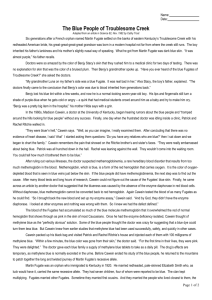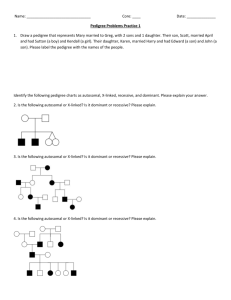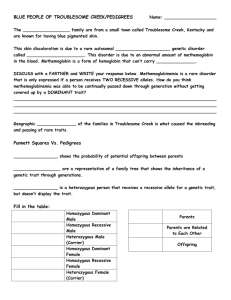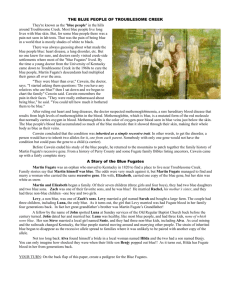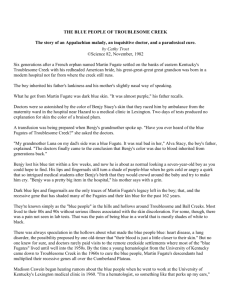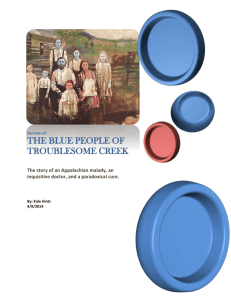The Blue People of Troublesome Creek
advertisement
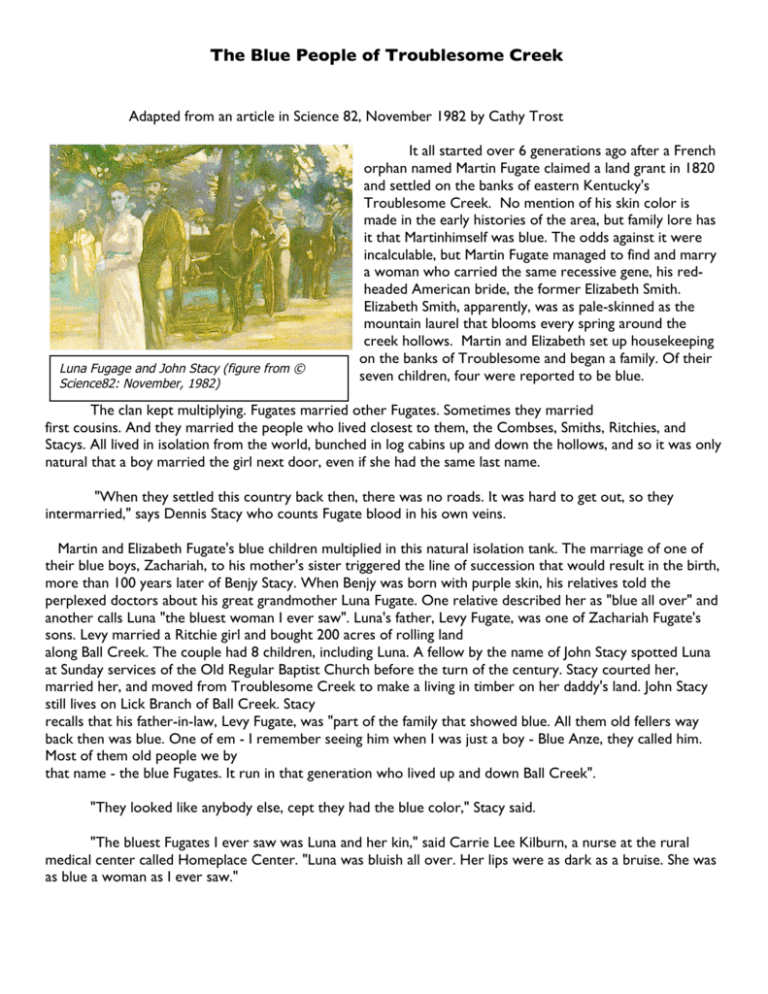
The Blue People of Troublesome Creek Adapted from an article in Science 82, November 1982 by Cathy Trost Luna Fugage and John Stacy (figure from © Science82: November, 1982) It all started over 6 generations ago after a French orphan named Martin Fugate claimed a land grant in 1820 and settled on the banks of eastern Kentucky's Troublesome Creek. No mention of his skin color is made in the early histories of the area, but family lore has it that Martinhimself was blue. The odds against it were incalculable, but Martin Fugate managed to find and marry a woman who carried the same recessive gene, his redheaded American bride, the former Elizabeth Smith. Elizabeth Smith, apparently, was as pale-skinned as the mountain laurel that blooms every spring around the creek hollows. Martin and Elizabeth set up housekeeping on the banks of Troublesome and began a family. Of their seven children, four were reported to be blue. The clan kept multiplying. Fugates married other Fugates. Sometimes they married first cousins. And they married the people who lived closest to them, the Combses, Smiths, Ritchies, and Stacys. All lived in isolation from the world, bunched in log cabins up and down the hollows, and so it was only natural that a boy married the girl next door, even if she had the same last name. "When they settled this country back then, there was no roads. It was hard to get out, so they intermarried," says Dennis Stacy who counts Fugate blood in his own veins. Martin and Elizabeth Fugate's blue children multiplied in this natural isolation tank. The marriage of one of their blue boys, Zachariah, to his mother's sister triggered the line of succession that would result in the birth, more than 100 years later of Benjy Stacy. When Benjy was born with purple skin, his relatives told the perplexed doctors about his great grandmother Luna Fugate. One relative described her as "blue all over" and another calls Luna "the bluest woman I ever saw". Luna's father, Levy Fugate, was one of Zachariah Fugate's sons. Levy married a Ritchie girl and bought 200 acres of rolling land along Ball Creek. The couple had 8 children, including Luna. A fellow by the name of John Stacy spotted Luna at Sunday services of the Old Regular Baptist Church before the turn of the century. Stacy courted her, married her, and moved from Troublesome Creek to make a living in timber on her daddy's land. John Stacy still lives on Lick Branch of Ball Creek. Stacy recalls that his father-in-law, Levy Fugate, was "part of the family that showed blue. All them old fellers way back then was blue. One of em - I remember seeing him when I was just a boy - Blue Anze, they called him. Most of them old people we by that name - the blue Fugates. It run in that generation who lived up and down Ball Creek". "They looked like anybody else, cept they had the blue color," Stacy said. "The bluest Fugates I ever saw was Luna and her kin," said Carrie Lee Kilburn, a nurse at the rural medical center called Homeplace Center. "Luna was bluish all over. Her lips were as dark as a bruise. She was as blue a woman as I ever saw." Luna Stacy possessed the good health common to the blue people bearing at least 13 children before she died at 84. The clinic rarely saw her and never for anything serious. Benjy Stacy was born in a modern hospital near Hazard, Kentucky, not far from Troublesome Creek. He inherited his father's lankiness and his mother's red hair but what he got from his great, great, great grandfather was dark blue skin! The doctors were astonished, not so the parents, but the boy was rushed off to a medical clinic in Lexington (University of Kentucky Medical School). Two days of tests showed no cause for Benjy's blue skin. Benjy's grandmother Stacy asked the doctor's if they had heard of the blue Fugates of Troublesome Creek. Put on that track, they concluded that Benjy's condition was inherited. Benjy lost his blue tint within a few weeks and now he is about as normal a 7-year old boy as you might imagine. His lips and fingernails still turn a purplish blue when he gets cold or angry and that trait was exploited by the medical students back when Benjy was an infant. Hilda Stacy (Benjy’s mother; nee Godsey) is fiercely protective of her son. She gets upset at all the talk of inbreeding among the Fugates. One of the supermarket tabloids once sent a reporter to find out about the blue people, and she was distressed with his preoccupation with intermarriages. She and her husband Alva have a strong sense of family. They sing in the Stacy Family Gospel Band and have provided their children with a beautiful home and a menagerie of pets, including horses. Benjy Stacy is one of the last of the blue Fugates. With Fugate blood on both his mother's and his father's side, the boy could have received genes for the enzyme deficiency from either direction. Because the boy was intensely blue at birth but then recovered his normal skin tones, Benjy is assumed to have inherlted only one gene for the condition. Such people tend to be very blue only at birth, probably because newborns normally have smaller amounts of diaphorase. The enzyme eventually builds to normal levels in most children and to almost normal levels in those like Benjy, who carry one gene. A commentary on this story The original article in Science 82 A pedigree based on the Science82 article A pedigree based on genealogical information Information on the inherited disorder affecting the "Blue People" of Kentucky. Enzyme affected in blue people Enzyme activity of blue people NADH Diaphorase Allele Frequencies The Straight Dope on the "Blue People". History of Hazard KY and Perry County A message from Ben Stacy This document maintained by Robert J. Huskey Last updated on September 14, 1999. http://www.people.virginia.edu/~rjh9u/fugate.html

